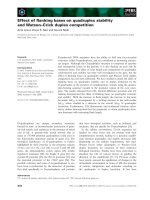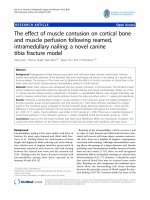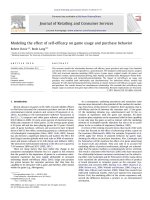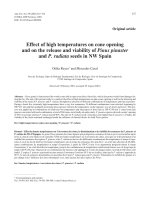Effect of heat stress on poultry production and their managemental approaches
Bạn đang xem bản rút gọn của tài liệu. Xem và tải ngay bản đầy đủ của tài liệu tại đây (183.99 KB, 8 trang )
Int.J.Curr.Microbiol.App.Sci (2019) 8(2): 1548-1555
International Journal of Current Microbiology and Applied Sciences
ISSN: 2319-7706 Volume 8 Number 02 (2019)
Journal homepage:
Review Article
/>
Effect of Heat Stress on Poultry Production and
their Managemental Approaches
Ashish Ranjan1*, Ranjana Sinha2, Indu Devi3, Abdul Rahim4 and Shiwani Tiwari5
1
Division of Animal Genetics and Breeding, ICAR-NDRI, Karnal-132001, Haryana, India
2
Semen sexing in cattle, ICAR-NDRI, Karnal-132001, Haryana, India
3
CSWRI, Avikanagar, Rajsthan 304501, India
4
CSWRI, Garsa (Himachal Pradesh)-175141, India
5
Livestock Production and Management, COA, JNKVV, Jabalpur,
(Maghya Pradesh)-482004, India
*Corresponding author
ABSTRACT
Keywords
Broiler, Egg
production, Heat
stress, Poultry,
Ventilation
Article Info
Accepted:
12 January 2019
Available Online:
10 February 2019
Air temperature and relative humidity are two primary environmental factors in terms of
THI that determining the heat stress level in livestock. Heat stress has detrimental effects
on egg production, egg quality of laying hen and reduced growth rate in broiler production.
Exposure of environmental stress during the growing period of broilers has been coupled
with undesirable meat quality. Heat stress has adverse effects on behaviour, welfare and
immunity of poultry and decreases the egg production resulting in massive economic
losses of farmer. The management approaches to minimise the adverse effect of heat stress
in poultry production viz., provision of ventilation, density of bird, nutritional
manipulation, supplementation of minerals and electrolyte. Controlling the environmental
variation is a critical to successful poultry production and welfare.
Introduction
Poultry production is one of the fastest
growing sectors of livestock industry in
developing
countries.
Environmental
variation is one of the major factors that affect
sustainability of livestock production systems
in tropical climate (Sinha et al., 2017a). Heat
Stress decline production performance and
death of chicken results in adversely affects
the return from the enterprise. Heat stress has
an adverse effect on egg production, egg
weight and shell quality of laying hen
(Muiruri and Harrison, 1991; Balnave and
Muheereza, 1997; Whitehead et al., 1998).
Climatic variables like temperature, humidity,
radiation and wind speed that directly affect
the mechanism of thermoregulation and rates
of heat exchange by all animals (NRC, 1981).
Heat stress is a major factor that decreases
productivity and reproductive efficiency of
livestock due to lower feed intake and
negative energy balance (De Rensis and
Scaramuzzi, 2003). Chronic heat stress had
1548
Int.J.Curr.Microbiol.App.Sci (2019) 8(2): 1548-1555
lower broiler production due to decline feed
digestibility such as proteins, fats, starch
(Bonnet et al., 1997). In addition, acute heat
stress drastically decreases reproductive
performance of hens due to alterations in
acid-base balance and ion exchange
mechanism (Mahmoud et al., 1996). Increase
of temperature will lead to increases etiologic
bacteria and parasites around the animals in
surrounding environment. Climate change
influences the emergence of disease and their
transmission due to increases vectors,
pathogens.
The signs of heat stress in poultry are panting
with open mouth, elevated their wings and
squatting near to the ground, droopy acting,
slowness and lethargic closed eyes, lying
down, increased water intake, decreased
appetite, drop in egg production, reduced egg
size, poor egg shell quality, reduced body
weight, and increased cannibalism (Nardone
et al., 2010; Dayyani and Bakhtiyari, 2013).
Birds are trying to lose heat by gasping and
changing the position of their feathers, losing
water in their breath and cooling by
evaporation through the surface of the lungs.
Birds are facing to heat stress conditions, they
spend less feeding time during feeding, more
time drinking and panting, less time moving
or walking and more time resting (Mack et
al., 2013).
2007). Exposure of bird to high solar
radiation is coupled with depression of
chemical composition and meat quality in
broilers industry (Dai et al., 2012; Imik et al.,
2012). Exposure of high temperature during
the growing phase of broilers has been related
with poor meat characteristics of broiler
chicken and loss their quality (Lu et al., 2007;
Zhang et al., 2012). Moreover, exposure of
heat stress during transportation of birds from
production farms to processing centre has
been losses meat quality (Dadgar et al.,
2010). Exposure of laying hens to climatic
stress also resulted in a significant decrease in
egg production and egg quality. Various
author reported that reducing egg production
in hot weather due to decrease in feed intake,
reducing the uptake of available nutrients and
decreases
digestibility
of
different
components of the diet (Allahverdi et al.,
2013; Kirunda et al., 2001; Mashaly et al.,
2004). So, egg production is inversely
correlated with environmental temperature
beyond the critical limit. Allahverdi et al.,
(2013) reported that laying flock in high
temperature shows disturbances in acid-base
balance in the blood as result of
hyperventilation, the birds gasp there is
excessive loss of CO2 gas from their lungs.
The lowered amount of CO2 in blood causes
the rise in blood PH which reduces the level
of Ca2+ ion in the blood that utilized by the
shell gland results poor egg quality
(Mahmoud et al., 1996).
Effect of heat stress on poultry production
Effect of heat stress on reproduction
Heat stress adversely affects the efficiency of
broiler production and their meat quality.
High environmental temperature and THI
value above the critical thresholds level lead
to reduced feed intake, lower body weight,
and lower feed conversion efficiency (Sohail
et al., 2012). Chronic heat exposure adversely
affects the meat quality and fat deposition in
broilers, but it is breed dependent (Lu et al.,
Heat stress has a great impact on the
reproductive performance and egg quality of
birds (Donoghue et al., 1989). High
temperature with high relative humidity has
more detrimental effect on reproduction of
animal. Exposure of White Leghorn hens to
high environmental temperature to causes
decline in reproductive activity leads to
reproductive failure and poor egg quality
Sign of heat stress in poultry
1549
Int.J.Curr.Microbiol.App.Sci (2019) 8(2): 1548-1555
(Ebeid et al., 2012). The reduction in
reproductive performance of domestic birds
coupled with heat stress due to decrease LH
levels and hypothalamic gonadotropinreleasing hormone-I content (Donoghue et al.,
1989; Etches et al., 1995). Diminishing
reproductive performance of poultry in heat
stress due to disturbance the thermoregulatory mechanisms, might be modulated
at the level of the hypothalamus and pituitary
(El Halawani et al., 1973; Saarela et al.,
1977).
Effect of heat stress on behavioral and
physiological responses
Thermoregulation is an important role in
maintaining the homeostasis and it is
controlled by central, metabolic and
endocrine systems. The body mass,
confirmation and morphological parameters
such as fur color are related to basal
metabolic rate, can use of behavioral
adjustments (Canals et al., 1989; Cooper et
al., 2008). Thermoregulatory capacities of
animal play an adaptive role to survive in
adverse
environment.
Under
high
environmental temperature, birds change their
behavioural and physiological responses to
maintain their body temperature through
seeking thermoregulation. Birds are subjected
to under heat stress conditions time spend less
in feeding, more in drinking, panting, and
wings elevation, move towards cooler
surfaces (Mack et al., 2013). In adverse
climatic condition, maintaining homeostasis
mechanism in birds by heat exchange
between environment and air sac through
convection, evaporative heat loss, perspiration
and vasodilation process (Mustaf et al., 2009;
Fedde, 1998).
Effect of heat stress on the immunolgical
responses
Heat stress has negative effects on health
status of birds leading to changes in
physiology, metabolism, hormonal and
immune system. At high temperature
decreases synthesis of T and B lymphocytes
and suppression of phagocytic activity of
blood leukocytes (Kadymov and Aleskerov,
1988). Bartlett and Smith (2003) found that
lower levels of total circulating antibodies and
lower levels of specific IgM and IgG in
broiler under heat stress. Nathan et al., (1976)
reported that decrease total WBC and
activities of leukocytes subsequent heat
exposure. Zulkifi et al., (2000) also supported
that heat stress had significantly decline in
antibody production. Inflection of the immune
response by the central nervous system
(CNS), and is mediated by a complex network
of nervous, endocrine and immune systems.
Management approaches to reduce heat
stress poultry
To reduce the heat stress in poultry is the
multidisciplinary approach. Modification of
surrounding environment, ventilation system,
bird density and nutritional management to
reduces the heat stress in poultry (Dayyani
and Bakhtiyari, 2013).
Modification of surrounding environment
Environmental temperature and relative
humidity of the surrounding environment
affects the evaporative cooling mechanism in
birds. Evaporative heat loss increases in high
temperature with wind speed but decreases
with increasing humidity (Lin et al., 2005;
Sinha et al., 2017b). The surrounding
environment is controlled by using various
things such as fans, fogger with fan, cooling
pads, curtain, static pressure controllers and
thermostats. Provision of intermittent light
had positive effect that related to lower heat
production in poultry (Ketelaars et al., 1986).
The orientation of building, insulation and
roof overhang are influence the temperature
inside the poultry house. Air movement inside
1550
Int.J.Curr.Microbiol.App.Sci (2019) 8(2): 1548-1555
the house is important for efficient
ventilation. Use of sprinkler and fogger with
fan reduces the temperature inside the house
on hot climatic condition (Sinha et al., 2018).
Environmentally controlled houses used
mechanical ventilation systems and air
movement is produced by fans and exhaust
fan in the building.
Ventilation system
Good ventilation system is essential for heat
stress management. Removes the moisture
loaded air from the poultry house and enter
equal amount of fresh air from outside.
Ventilation system should be maximized as
the air movement assist removal of ammonia,
moisture and carbon dioxide from the poultry
house and enter fresh oxygen from outside
(Butcher and Miles, 2012). Proper ventilation
houses can provide consistent airflow
patterns. Tunnel ventilation connects moving
air of building from inlets to exhaust fans,
providing high airflow speed. This fast air
movement increases convective heat loss,
reducing the body temperature of birds. The
air velocity of tunnel ventilation is about 350
feet/minute. Evaporative cooling pads works
on the same cooling principle as foggers, air
is cooled inside the house when it passes
through the cooling pads. Circulation fans are
recommended for proper ventilation in a good
ventilated house for maximizes air movement
over the birds to increase convective cooling.
The installation of circulation fans at 1 – 1.5
metre above the floor and tilted downward
about 5° angle for producing maximum air
over the birds (Daghir, 2008).
Nutritional management
Reduce the heat stress in poultry by
nutritional management approaches. Decrease
in feed intake and increase water intake of
poultry under hot climate to control the body
temperature (Gous and Morris, 2005; Sohail
et al., 2012). Feed intake will be reduced by
1.2% for every 1°C rise in the temperature
range of 22-32°C and 5% for 1°C rise in the
temperature range of 32-38°C. Feeding of
laying hens during the evening period has
been found to improve laying rate and egg
shell quality through increased calcium
intake. Vitamins and mineral supplementation
has been determine to decrease mortality and
improve growth performance of poultry birds
during heat stress as because heat stress
increases excretion of mineral from body and
decreases the serum and liver concentrations
of vitamins and minerals (Sahin et al., 2009).
Addition of fat and reduction of excess fat in
poultry ration are recommended to minimise
the adverse effect of heat stress (Ghazalah et
al., 2008; Rahman et al., 2002). The addition
of fat up to 5 % in the diet increases the
energy value of feed constituents and
decreases the rate of food passage in the GI
tract and thus increase nutrient utilization
(Mateos et al., 1982; Daghir, 2008).
Supplementation of minerals like ammonium
chloride (NH4Cl) sodium bicarbonate
(NaHCO3),
sodium
chloride
(NaCl),
potassium chloride (KCl) and potassium
sulphate (K2SO4) in drinking water of
poultry are beneficial effect under heat stress
condition (Smith and teeter, 1988; Ubosi et
al., 2003; Ahmad et al., 2005). Teeter et al.,
(1985) reported that supplementation of
NH4Cl at 3 and 10 g/kg in poultry feed under
high
environment
temperature
had
improvement in weight gain up to 9.5 and 25
% respectively. Supplementation of vitamin C
under high temperature is most effective to
reducing mortality rate in broiler and laying
hens (Njoku, 1986; Ahmed et al., 2005).
Vitamin C acts as antistressor and growth
stimulant in commercial broiler production
due to maintenance of normal collagen
metabolism (Mahmoud et al., 2004;
McDonald et al., 1992). Supplementation of
vitamin E during heat stress was beneficial to
laying hens, maintain the biological
1551
Int.J.Curr.Microbiol.App.Sci (2019) 8(2): 1548-1555
membranes because protects cells and tissues
from oxidative damage induced by free
radicals (Whitehead et al., 1998; Sahin et al.,
2001).
Water intake
At high temperatures, chickens consume more
water than feed. The reduced water intake is
primarily behind the decrease in production.
Water intake of birds increases about 7% for
every 1°C increase above 21°C (NRC, 1994).
Birds performance depends upon water
temperature, drinker type, shape and height of
water trough under heat stress (May et al.,
1997; Daghir, 2009). May et al., (1997)
observed that significant decrease in water
intake of birds at high ambient temperature
from nipple drinkers as compared to bell
drinkers.
It is concluded that heat stress adversely
affects the commercial poultry production
through reduced feed intake and high
mortalities. The negative effects of heat stress
on broilers and laying hens, reduced growth
and egg production to deteriorate egg quality.
High environmental temperature increases
mortality of poultry due to inhibition of
immune responses. Feeding management
practices such as changes in energy: protein
ratio, wet feeding, feeding time, drinker type
and height had improved performance under
high environmental temperature.
References
Ahmad, T., Sarwar, M., Mahr-Un-Nisa,
Ahsan-Ul-Haq
and
Zia-Ul-Hasan,
(2005). Influence of varying sources of
dietary electrolytes on the performance
of broiler reared in a high temperature
environment. Animal Feed Sci. and
Technol., 20: 277-298.
Ahmed, N., Haldar, S., Pakhira, M.C. and
Ghosh,
T.K.
(2005).
Growth
performances, nutrient utilization and
carcass traits in broiler chickens fed with
a normal and a low energy diet
supplemented with inorganic chromium
and ascorbic acid. J. Agric. Sci., 143:
427-439.
Allahverdi, A., Feizi, A., Takhtfooladi, H.A.
and Nikpiran, A. (2013). Effects of Heat
Stress on Acid-Base Imbalance, Plasma
Calcium Concentration, Egg Production
and Egg Quality in Commercial Layers.
Global Veterinaria., 10(2): 203-207.
Balnave, D. and Muheereza, S.K. (1997).
Improving eggshell quality at high
temperatures with dietary sodium
bicarbonate. Poult. Sci., 76: 558–593.
Bartlett, J.R. and Smith, M.O. (2003). Effects
of different levels of zinc on the
performance and immunocompetence of
broilers under heat stress. Poult. Sci., 82:
1580–1588.
Bonnet, S., Geraert, P.A. Lessire, M. Carre,
B. and Guillaumin, S. (1997). Effect of
high ambient temperature on feed
digestibility in broilers. Poult. Sci., 76:
857–863
Butcher, G.D. and Miles, R. (2012). Heat
stress management in broilers. VM65
series of the Veterinary Medicine Large
Animal Clinical Sciences Department,
Florida Cooperative Extension Service,
Institute of Food and Agricultural
Sciences, University of Florida
Canals, M., Rosenmann, M. and Bozinovic, F.
(1989). Energetics and geometry of
huddling in small mammals. J.
Theoretical Biology., 141(2): 181-189.
Cooper C.E. and Geiser, F. (2008). The
"minimal
boundary
curve
for
endothermy" as a predictor of
heterothermy in mammals and birds: a
review.
Journal
of
Comparative
Physiology B-Biochemical Systemic and
Environmental Physiology, 178(1), 1-8.
Dadgar, S., Lee, S.S., Leer, T.L.,
Burlinguette, N., Classen., H.L., Crowe,
1552
Int.J.Curr.Microbiol.App.Sci (2019) 8(2): 1548-1555
T.G. and Shand, P.J. (2010). Effect of
microclimate
temperature
during
transportation of broiler chickens on
quality of pectoralis major muscle. Poult.
Sci., 89: 1033-1041.
Daghir, N.J. (2008). Broiler feeding and
management in hot climates, in: Daghir,
N.J. (Ed.) Poultry production in Hot
Climate,
pp.
227-260
(CAB
International.
Cromwell
Press,
Trowbridge)
Daghir, N.J. (2009). Nutritional strategies to
reduce heat stress in broilers and broiler
breeders. Lohmann information. 44: 615.
Dai, S.F., Gao, F., Xu, X.L., Zhang, W.H.,
Song, S.X. and Zhou, G.H. (2012).
Effects of dietary glutamine and gammaaminobutyric acid on meat colour, pH,
composition,
and
water-holding
characteristic in broilers under cyclic
heat stress. Br. Poult. Sci., 53: 471–481.
Dayyani, N. and Bakhtiyari, H. (2013). Heat
stress in poultry: background and
affective factors. International journal of
Advanced Biological and Biomedical
Research. 1(11): 1409-1413
De Rensis, F. and Scaramuzzi, R.J. (2003).
Heat stress and seasonal effects on
reproduction in the dairy cow-a review.
Theriogenology., 60: 1139e51
Donoghue, D.J., Krueger, B.F. Hargis, B.M.
Miller, A.M. and El Halawani, M.E.
(1989). Thermal stress reduces serum
luteinizing hormone and bioassayable
hypothalamic content of luteinizing
hormone-releasing hormone in hens.
Biol. Reprod., 41: 419–424.
Ebeid, T.A., Suzuki, T. and Sugiyama, T.
(2012). High ambient temperature
influences
eggshell
quality
and
calbindin-D28k localization of eggshell
gland and all intestinal segments of
laying hens. Poultry Sci., 91: 2282–2287.
El Halawani, M.E., Waibel, P.E., Appel, J.R.
and Good, A.L. (1973). Effects of
temperature stress on catecholamines and
corticosterone of male turkeys. Am. J.
Physiol., 224: 384–388.
Etches, R.J., John, T.M. and Gibbins. V.A.M.
(1995). Behavioural, physiological,
neuroendocrine and molecular responses
to heat stress. Pages 31–65 in Poultry
Production in Hot Climates. N. J. Daghir,
ed. CAB Int., Wallingford, UK.
Fedde, M.R. (1998). Relationship of structure
and function of the avian respiratory
system to disease susceptibility. Poult.
Sci., 77: 1130-1138.
Ghazalah, A.A., Abb-Elsamee, M.O. and Ali,
A.M. (2008). Influence of dietary energy
and poultry fat on the response of broiler
chicks to heat stress. Int. J. Poult. Sci., 7:
355-359
Gous, R.M. and Morris, T.R. (2005).
Nutritional interventions in alleviating
the effects of high temperatures in broiler
production. World’s Poult. Sci. J., 61:
463-475.
Imik, H., Atasever, M.A., Urgar, S., Ozlu, H.,
Gumus, R. and Atasever, M. (2012).
Meat quality of heat stress exposed
broilers and effect of protein and vitamin
E. Br. Poult. Sci., 53: 689–698.
Kadymov, R.A. and Aleskerov, Z.A. (1988).
Immunological reactivity of poultry
organism under high temperature
conditions. Dokl. Vses. Akad. S-Kh.
Nauk Im. V. I. Lenina 5: 33–35
Ketelaars, E.H., Verbrugge, M., Van Der Hel,
W., Van De Linden, J.M. and Verstegen,
W.M.A. (1986). Effect of intermittent
lighting on performance and energy
metabolism of broilers. Poultry Sci., 65:
2208–2213.
Kirunda, D.F., Scheideler, S.E. and McKee.
S.R. (2001). The efficacy of vitamin E
(DL-alpha-tocopheryl
acetate)
supplementation in hen diets to alleviate
egg quality deterioration associated with
high temperature exposure. Poult. Sci.,
80: 1378–1383.
1553
Int.J.Curr.Microbiol.App.Sci (2019) 8(2): 1548-1555
Lin, H., Zhang, H.F., Du, R., Gu, X.H.,
Zhang, Z.Y., Buyse, J. and Decupere, E.
(2005). The thermoregulation response
of broiler chickens to humidity at
different ambient temperatures I. Fourweek-age. Poultry Sci., 84: 1173-1178.
Lu, Q., Wen, J. and Zhang, H. (2007). Effect
of chronic heat exposure on fat
deposition and meat quality in two
genetic types of chicken. Poult. Sci., 86:
1059–1064.
Mack, L.A., Felver-Grant J.N., Dennis, R.L.
and Cheng, H.W. (2013). Genetic
variation
aiter
production and behavioral responses
following heat stress in 2 strains of
laying hens. Poult. Sci., 92: 285-294.
Mahmoud, K.Z., Beck, M.M., Scheider, S.E.,
Forman, M.F., Anderson, K.P. and
Kachman, S.D. (1996). Acute high
environmental temperature and calciumestrogen relationship in the hen. Poult.
Sci., 75: 1555-1562.
Mahmoud, K.Z., Edens, F.W., Eisen, E.J. and
Havenstein, G.B. (2004). Ascorbic acid
decreases heat shock protein 70 and
plasma corticosterone response in
broilers subjected to cyclic heat stress.
Comparative
Biochemistry
and
Physiology Part B: Biochem. & Biology.,
137(1): 137-142.
Mashaly, M.M., Hendricks, G.L., Kalama,
M.A., Gehad, A.E., Abbas, A.O. and
Patterson, P.H. (2004). Effect of heat
stress on production parameters and
immune responses of commercial laying
hens. Poult Sci., 83: 889-894.
Mateos, G.G., Sell, J.L. and Eastwood, J.A.
(1982). Rate of food passage as
influenced by level of supplemental fat.
Poult. Sci., 61: 94-100.
May, J.D., Lott, D.B. and Simmons, J.D.
(1997). Water consumption by broilers in
high cyclic temperatures: bell versus
nipple waterers. Poult. Sci., 76: 944-947.
McDonald, P., Edward, R.A. and Greenholgh,
J.F.D. (1992). Animal Nutrition.
Longman Scientific and Tech., New
York, USA, Pp- 88.
Muiruri, H.K., and Harrison, P.C. (1991).
Effect of roost temperature on
performance of chickens in hot ambient
environments. Poult. Sci., 70:2253–2258
Mustaf, S., Kahraman, N.S. and Firat, M.Z.
(2009). Intermittent partial surface
wetting and its effect on body-surface
temperatures and egg production of
white brown domestic laying hens in
Antalya (Turkey). Br. Poult. Sci., 50: 3338.
Nardone, A., Ronchi, B., Lacetera, N.,
Ranieri, M.S. and Bernabucci, U. (2010).
Effects of climate change on animal
production and sustainability of livestock
systems. Livestock Sci., 130: 57 69.
Nathan, D.B., Heller, E.D. and Perek, M.
(1976). The effect of short heat stress
upon
leucocyte
count,
plasma
corticosterone
level,
plasma
and
leukocyte ascorbic acid content. Br.
Poult. Sci. 17: 481–485.
Njoku, P.C. (1986). Effect of dietary ascorbic
acid supplementation on the performance
of broiler chickens in a tropical
environment. Anim. Feed. Sci. Tech., 16:
17-24.
NRC, (1994). Nutrient requirements of
poultry. 9ed National Academy Press,
Washington, DC.
NRC. (1981). Effect of environment on
nutrient requirements of domestic
animals.
Committee
on
Animal
Nutrition.
Subcommittee
on
Environmental Stress. National Academy
Press, Washington DC.
Rahman, M.S., Pramanik, M.A.S., Basak, B.,
Tarafdar, S.U. and Biswas, S.K. (2002).
Effect of feeding low protein diets on the
performance of broilers during hothumid season. Int. J. Poult. Sci., 1: 35-39
Saarela, S., Hissa, R., Hohtola, E. and
Jeronen, E. (1977). Effects of -methyl-
1554
Int.J.Curr.Microbiol.App.Sci (2019) 8(2): 1548-1555
para-tyrosine and temperature stress on
monoamine and metabolite level in the
pigeon. J. Therm. Biol., 2: 121–126
Sahin, K., Sahin, N., Kucuk, O., Hayirli, A.
and Prasad, A.S. (2009). Role of dietary
zinc in heat stressed poultry: A review.
Poult. Sci., 88: 2176-2183.
Sahin, K., Sahin, N., Onderct, M., Yaralioglu,
S. and Kucuk, O. (2001). Protective role
of
supplemental vitamin E on lipid
peroxidation, vitamins E, A. and some
mineral concentrations of broilers reared
under heat stress. Vet. Med. Czech.,
46(5): 140-144.
Sinha R., Kamboj, M.L., Lathwal, S.S., and
Ranjan, A. (2018). Effect of housing
management on production performance
of crossbred cows during hot-humid
season. Indian J. Anim. Res., 52 (7):
1091-1094.
Sinha, R., Kamboj M.L., Ranjan, A. and
Lathwal, S.S. (2017b). Effect of
modified housing on behavioural and
physiological responses of crossbred
cows in hot humid climate. Indian J.
Anim. Sci., 87 (10): 1255–1258.
Sinha, R., Lone, S.A., Ranjan, A., Rahim, A.,
Devi, I and Tiwari, S. (2017a). The
impact of climate change on livestock
production
and
reproduction:
ameliorative management. International
Journal of Livestock Research., 7(6): 18.
Smith, M.O. and Teeter, R.G. (1988).
Practical application selection of
potassium chloride and fasting during
naturally occurring summer heat stress.
Poult. Sci., 64: 36.
Sohail, M.U., Hume, M.E., Byrd, J.A., Nisbet,
D.J., Ijaz, A., Sohail, A., Shabbir, M.Z.
and Rehman, H. (2012). Effect of
supplementation of prebiotic mannanoligosaccharides and probiotic mixture
on growth performance of broilers
subjected to chronic heat stress. Poult.
Sci., 91: 2235–2240.
Teeter, R.G., Smith, M.O. and Owens, F.N.
(1985). Chronic heat stress and
respiratory alkalosis: occurrence and
treatment in broiler chickens. Poult. Sci.,
64: 1060-1064.
Ubosi, C.O., Otika, A.E. and Diarra, S.S.
(2003). Effect of potassium chloride and
sodium bicarbonate supplementation on
the performance of laying hens in a hot
dry environment. Sahel J. Vet. Sci., 2:
23-26.
Whitehead,
C.C.,
Bollengier-Lee,
S.,
Mitchell, M.A. and Williams, P.E.V.
(1998). Vitamin E can alleviate the
depression in egg production in heat
stressed laying hens. In: Proc. Of spring
meeting,
WPSA-UK
Branch
Scarborough. Pp. 55-56
Zhang, Z.Y., Jia, G.Q., Zuo, J.J., Zhang, Y.,
Lei, J., Ren, L. and Feng, D.Y. (2012).
Effects of constant and cyclic heat stress
on muscle metabolism and meat quality
of broiler breast fillet and thigh meat.
Poult. Sci., 91: 2931-2937.
Zulkifi, I., Norma, M.T., Israf, D.A. and
Omar. A.R. (2000). The effect of early
age feed restriction on subsequent
response
to
high
environmental
temperatures in female broiler chickens.
Poult. Sci., 79:1401–1407.
How to cite this article:
Ashish Ranjan, Ranjana Sinha, Indu Devi, Abdul Rahim and Shiwani Tiwari. 2019. Effect of
Heat Stress on Poultry Production and their Managemental Approaches.
Int.J.Curr.Microbiol.App.Sci. 8(02): 1548-1555. doi: />
1555









